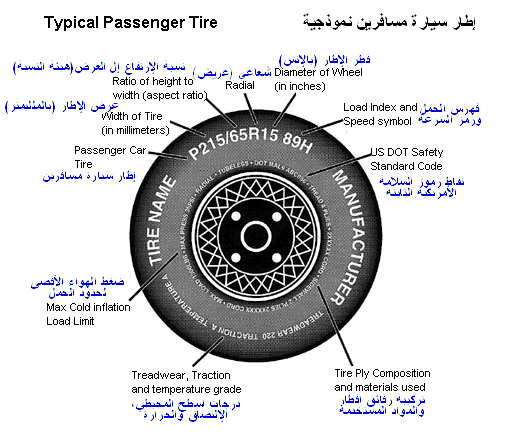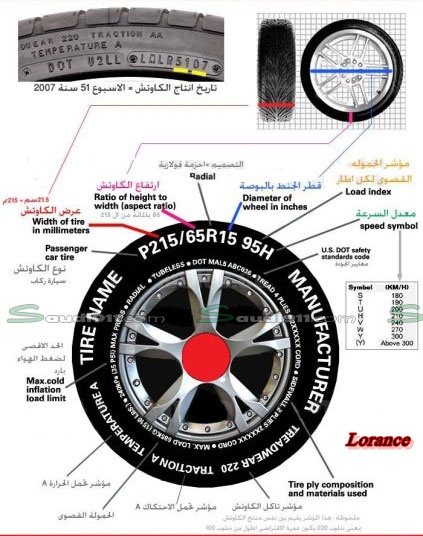Reading the Sidewall of a Tire
A metric tire’s section width is measured in millimeters. This measurement is taken from sidewall to sidewall. In this example, the section width of the tire is 205mm.
This number refers to the height of the sidewall. It is a percentage of the section width. In this example, 65 percent of the section width of 205mm equals 133.25.
The “R” in this example indicates radial tire construction.
Tire Dimensions
The linear distance between th outside of the sidewalls of an inflated tire without any load on it (this does not include any sidewall decorations).
This is also known as the Sectio Height. This is figured as a percentage of the section width. A tire size of 205/60R15 would have a section width of 205 millimeters and a section height of 60 percent of 205 millimeters.
The width between the flanges of the wheel (the part the bead of the tire touches).
Diameter – “35”
The first number indicates the tire’s diameter in inches. In this example, the tire manufacturer has determined that this is a 35″ tire. However, actual measured overall diameters vary from one manufacturer to the next.
Standard tire width is indicated in inches with the decimal point removed. Therefore, in this example, the number 1250 indicates that this tire is 12.5″ wide.
This letter indicates the load carrying capacity of the tire in terms of its construction. A “C” indicates the tire has a 6-ply load carrying capacity. The tire is not actually built with 6 plies, but contains one or two plies of equivalent strength. A “D” is an 8-ply rating, and an “E” is a 10-ply rating. If there is no letter, the tire has a standard 4-ply rating.


Load Index
| Load Index | Load (lbs) |
|---|---|
| 0 | 99 |
| 1 | 102 |
| 2 | 105 |
| 3 | 107 |
| 4 | 110 |
| 5 | 114 |
| 6 | 117 |
| 7 | 120 |
| 8 | 123 |
| 9 | 128 |
| 10 | 132 |
| 11 | 136 |
| 12 | 139 |
| 13 | 143 |
| 14 | 148 |
| 15 | 152 |
| 16 | 157 |
| 17 | 161 |
| 18 | 165 |
| 19 | 171 |
| 20 | 176 |
| 21 | 182 |
| 22 | 187 |
| 23 | 193 |
| 24 | 198 |
| 25 | 204 |
| 26 | 209 |
| 27 | 215 |
| 28 | 220 |
| 29 | 227 |
| 30 | 234 |
| 31 | 240 |
| 32 | 247 |
| 33 | 254 |
| 34 | 260 |
| 35 | 267 |
| 36 | 276 |
| 37 | 282 |
| 38 | 291 |
| 39 | 300 |
| 40 | 309 |
| 41 | 320 |
| 42 | 331 |
| 43 | 342 |
| 44 | 353 |
| 45 | 364 |
| 46 | 375 |
| 47 | 386 |
| 48 | 397 |
| 49 | 408 |
| Load Index | Load (lbs) |
|---|---|
| 50 | 419 |
| 51 | 430 |
| 52 | 441 |
| 53 | 454 |
| 54 | 467 |
| 55 | 481 |
| 56 | 494 |
| 57 | 507 |
| 58 | 520 |
| 59 | 536 |
| 60 | 551 |
| 61 | 567 |
| 62 | 584 |
| 63 | 600 |
| 64 | 617 |
| 65 | 639 |
| 66 | 639 |
| 67 | 677 |
| 68 | 694 |
| 69 | 716 |
| 70 | 739 |
| 71 | 761 |
| 72 | 783 |
| 73 | 805 |
| 74 | 827 |
| 75 | 852 |
| 76 | 882 |
| 77 | 908 |
| 78 | 937 |
| 79 | 963 |
| 80 | 992 |
| 81 | 1019 |
| 82 | 1047 |
| 83 | 1074 |
| 84 | 1102 |
| 85 | 1135 |
| 86 | 1168 |
| 87 | 1201 |
| 88 | 1235 |
| 89 | 1279 |
| 90 | 1323 |
| 91 | 1356 |
| 92 | 1389 |
| 93 | 1433 |
| 94 | 1477 |
| 95 | 1521 |
| 96 | 1565 |
| 97 | 1609 |
| 98 | 1653 |
| 99 | 1709 |
| Load Index | Load (lbs) |
|---|---|
| 100 | 1764 |
| 101 | 1819 |
| 102 | 1874 |
| 103 | 1929 |
| 104 | 1984 |
| 105 | 2039 |
| 106 | 2094 |
| 107 | 2149 |
| 108 | 2205 |
| 109 | 2271 |
| 110 | 2337 |
| 111 | 2403 |
| 112 | 2469 |
| 113 | 2535 |
| 114 | 2601 |
| 115 | 2679 |
| 116 | 2756 |
| 117 | 2833 |
| 118 | 2910 |
| 119 | 2998 |
| 120 | 3086 |
| 121 | 3197 |
| 122 | 3307 |
| 123 | 3417 |
| 124 | 3527 |
| 125 | 3638 |
| 126 | 3748 |
| 127 | 3858 |
| 128 | 3968 |
| 129 | 4079 |
| 130 | 4189 |
| 131 | 4289 |
| 132 | 4409 |
| 133 | 4541 |
| 134 | 4674 |
| 135 | 4806 |
| 136 | 4938 |
| 137 | 5071 |
| 138 | 5203 |
| 139 | 5357 |
| 140 | 5512 |
| 141 | 5677 |
| 142 | 5842 |
| 143 | 6008 |
| 144 | 6173 |
| 145 | 6393 |
| 146 | 6614 |
| 147 | 6779 |
| 148 | 6844 |
| 149 | 7165 |
| 150 | 7385 |
Speed Ratings
DOT
Brand Characteristics – “YYY”
Treadwear – “520”
Treadwear, Traction and Temperature
The treadwear grade is a comparative rating based on the wear of a tire when tested carefully under controlled conditions. For example the useful tread on a tire graded 400 should last twice as long as a tire graded 200. However, another tire manufacturer may grade a comparable design 300, so a grade of 150 would last just half as long under their grading scheme. The lesson learned is to not use one manufacturer’s grade versus the other, but instead to compare tire grades within a given brand. Actual treadwear performance can vary tremendously according to the tire’s real-world use. Variations in driving habits, service practices (most importantly air pressure maintenance), road conditions and climate affect tire life.
Maximum Load Limit – “635 kg [1400 lbs]”
Tire Construction
Rotation Direction
Tires that are both directional and asymmetrical will indicate what direction the tire must rotate, as well as what side must face outward from the vehicle.
